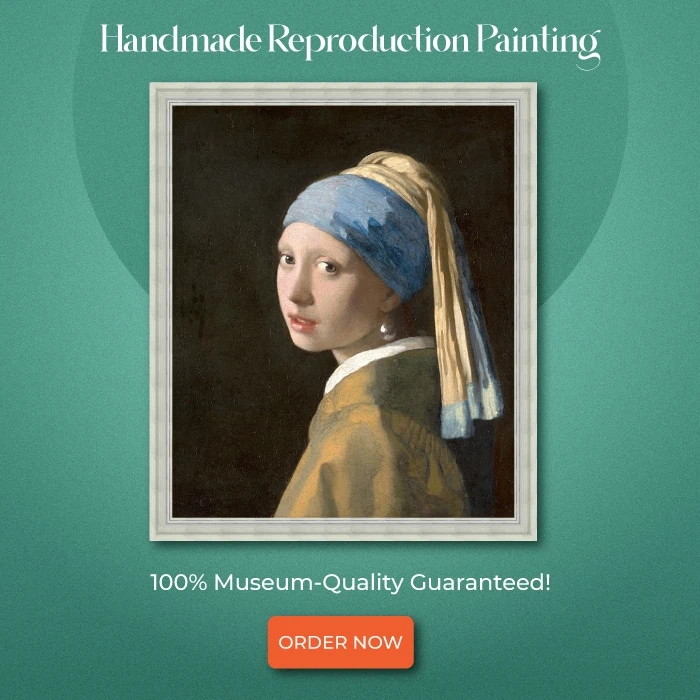Table of contents
- What sparked abstraction among artists?
- Wassily Kandinsky (1866-1944)
- Kazimir Malevich (1879-1935)
- Olga Rozanova (1886-1918)
- Pablo Picasso (1881-1973)
- Georges Baraques (1882-1963)
- Robert Delaunay (1885-1941)
- Henri Matisse (1869-1954)
- Marc Chagall (1887-1985)
- Andre Derain (1880-1954)
- Theo Van Dosenburg (1883-1931)
- Piet Mondrian (1872-1944)
- Hilma Af Klint (1862-1944)
- Mark Rothko (1903-1970)
- Willem De Kooning (1904-1997)
- Helen Frankenthaler (1928-2011)
- Jackson Pollock (1912-1956)
- Franz Kilne (1910-1962)
- Frank Stella (1936-present)
- Frequently Asked Questions
Human nature prohibits humanity from being bound by particular standards.
It always reaches out to break the shackles it puts on itself.
In every field, including the arts, there are people who embody this feeling.
And the ones who rejected the social norms for painting are regarded as abstract artists, who let art strive.
They are well known for their work.
Whether it’s defying the genre’s accepted norms or attempting to convey a message with their technique, these abstract artists would step into any situation
Notably, they were inspired by their unique situations, which is why they desired to express themselves through their art.
Talking about abstract innovators, we’ve listed 18 famous abstract painters whose art has caught and will continue to catch our attention.
What sparked abstraction among artists?
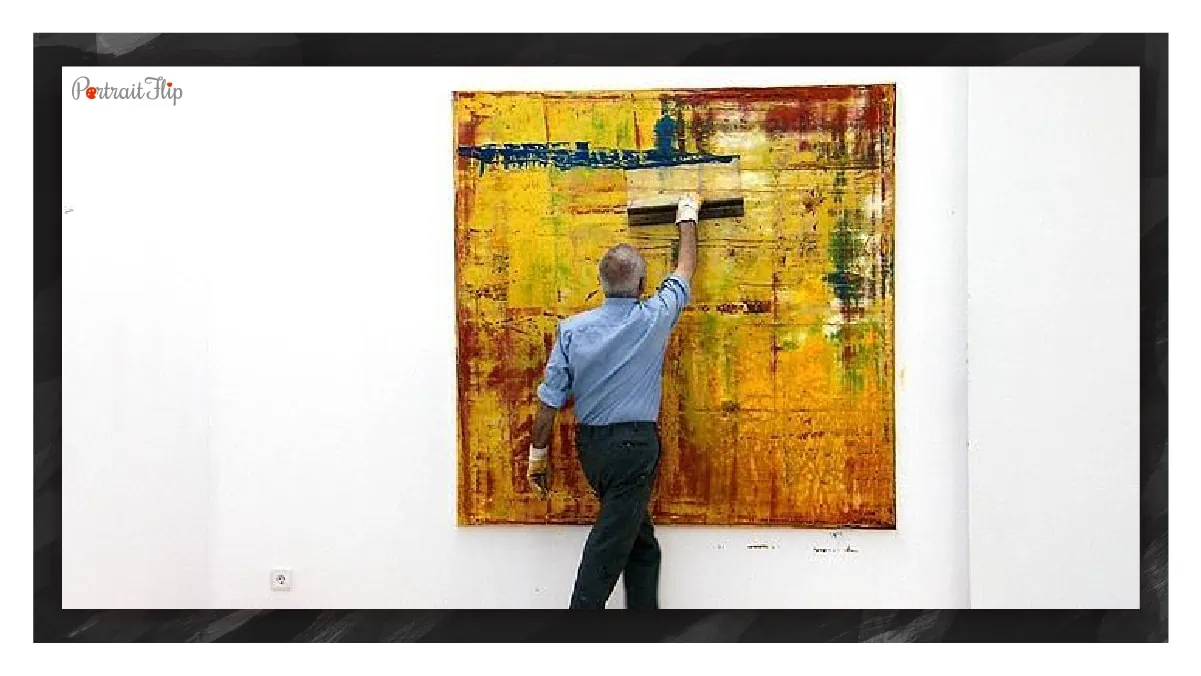
Prior to the birth of the abstract movement, artists were confined to creating works of art that were primarily intended to depict scenes from nature that illuminated the reality of human civilization and landscapes.
Due to this, the artists were forced to restrain their creativity, which made them unable to convey messages or provide context for their works of art.
However, as a form of rebellion, artists began to deviate from these standards in 1911, and create works that challenged them.
This movement to move away from the norms was coined “abstraction” in art.
Wassily Kandinsky (1866-1944)

Wassily Kandinsky, who used the term “abstract” to describe one of his paintings, is credited with starting the movement.
As a result, he is an abstract painter who is famously referred to as the “Father of Abstraction.”
The “Blue Rider” movement, which stood for German Expressionism, was also founded by him.
He, along with Franz Mare, aimed to direct artists more towards expressing themselves than sticking to traditional painting standards.
Later in life, he started teaching basic design classes for beginners and advanced theory at the Bauhaus.
Wassily relocated to Paris, where he observed a dynamic shift in his artwork at the time when the Nazis were gaining control over Germany.
Geometric lifeforms and outlines took over his paintings, which describe his inner life, as he said that was the time he felt his happiest.
Till the end of his life, total no. Wassily Kandinsky paintings was 228 and he was also responsible for writing two books.
Astonishing marvels like composition 8 by Kandinsky always fascinate us! Why not have them hung in your dining room?
Check out Kandinsky Replica paintings by PortraitFlip.
Suggested Read: Composition VII by Wassily Kandinsky
Kazimir Malevich (1879-1935)

Kazimir Malevich was the founder of the famous Russian abstract movement called “Suprematism.”
His famous abstract artworks were mainly about his philosophical ideas, which talk about non-objectivity and reforming art towards abstraction.
Although he experimented with many different art forms, the geometric forms and their relationships to the pictorial space surrounding the canvas were the main focus of his most famous abstract paintings.
After the October Revolution took place in Russia, Malevich became a member of the Collegium of the National Arts at Nokompras, where he wrote his book, “The World As Non-Objectivity.”
Malevich mostly believed that after the fall of communism in the Soviet State, there would be a shift in the attitude of artists towards modern art, and continuously strived to promote his beliefs.
This did not sit right with the authorities, and he was captured by the KGB in 1930.
However, this did not stop him from preaching his beliefs, and he famously quoted, “Art did not need us, and it never did.”
After suffering from cancer for some time, he died at the young age of 57.
(Read: 9 Artists of Pop Art Who Rejected The Notion Of Uniqueness)
Olga Rozanova (1886-1918)
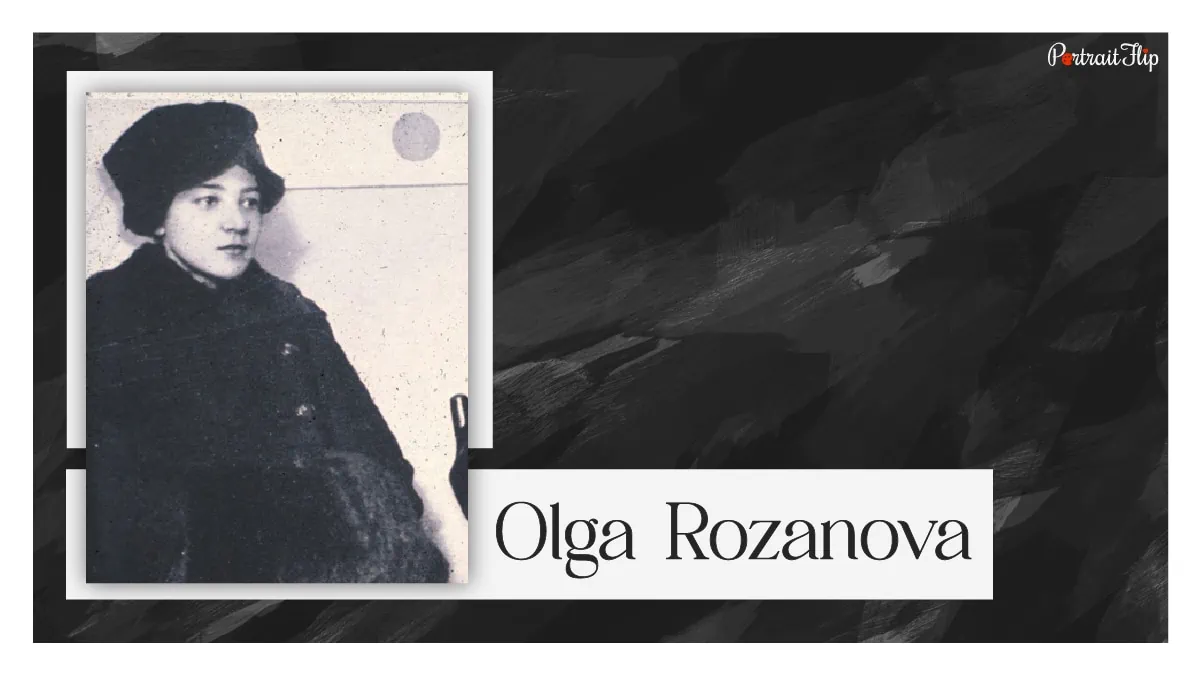
Olga was one of the most famous female painters who was a part of the Russian Avant Garde movements.
She added her own theories about abstract art, like color interaction, to the mix and increased awareness of Suprematism and cubo-futurism.
She was also known for adding translational poetry to her abstract art and producing energetic compositions that were mainly influenced by Kazimir Malevich.
However, after 1914, her artworks were inclined towards the movement of cubo-futurism.
As a part of that movement, her artwork started to move away from suprematism and focus on fragmentation and the displacement of traditional forms of artwork.
Sadly, in 1918, she passed away with diphtheria while she was just 32 years old.
During her last years, she was actively working on the preparations for the first anniversary of the October Revolution.
Pablo Picasso (1881-1973)
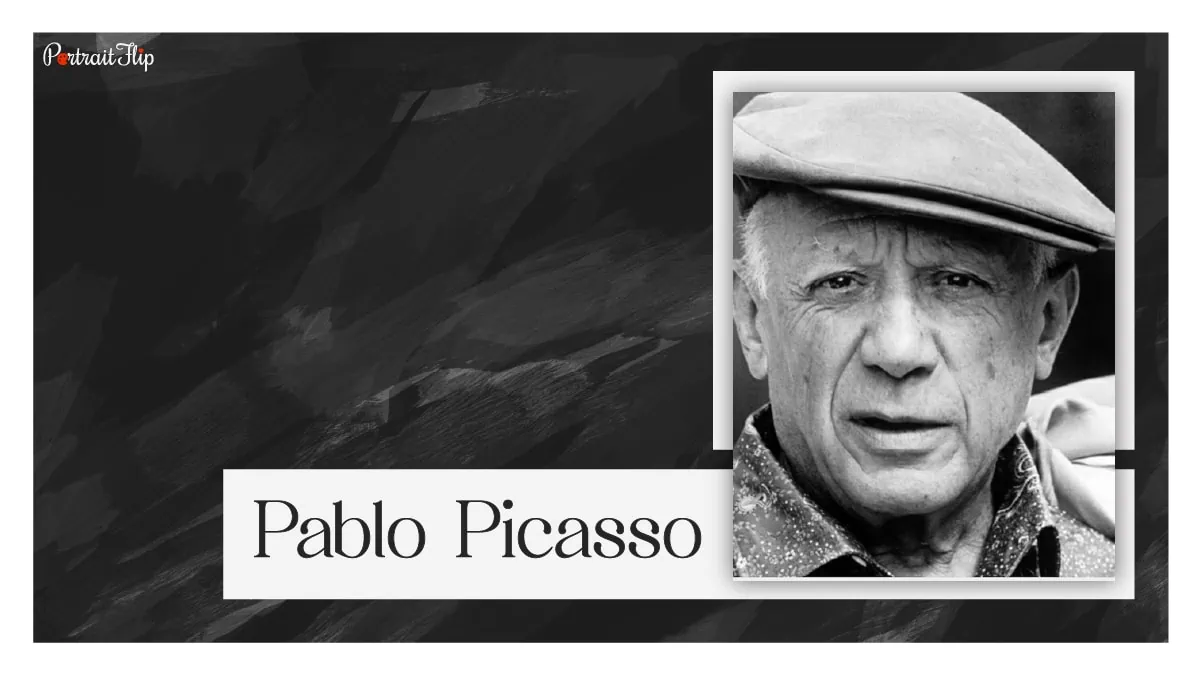
Pablo Picasso, was one of the most influential and important figures in art at the time.
His painting style was distinct; he had a large number of followers and critics.
Which helped him in many ways; he was able to take center stage and upthrust various art movements like cubism and abstract expressionism.
When his first artwork, Les Demoiselles d’Avignon, first hit the scene, it took the world by storm, as it was his first painting that abandoned the form and representation of his subjects.
Picasso was also later credited with pioneering constructive sculpturing and co-inventing the collage style of painting.
One of the most famous abstract painters, Picasso devoted his entire life to creating art, aiding in the advancement of modern art, and creating the cubism movement.
He died at the age of 91, with about 50,000 artworks to his name.
Georges Baraques (1882-1963)

Georges Baraque is known for being the co- founder of the cubist movement alongside the legendary Pablo Picasso.
He shared the ideology of abandonment of form with his subjects in his paintings.
In his early painting career, Georges was mostly inspired by impressionist artists like Vincent Van Gogh and Claude Monet.
Unlike the other cubist artists, he believed in generating space with the use of his colors and not just the geometry of his subjects.
After 1905, he slowly transitioned his artwork towards Fauvism, where he had the independence to use the ideas that he wanted to work with.
This is the time when he met up with the iconic Cubist artist, Pablo Picasso, and the two famous abstract painters worked together on developing a new style of art and giving depth to the artwork.
Together with Pablo, he also challenged the rules of art perspective, which had been in place since the Renaissance period.
His paintings took a darker turn and became more sad and depressing after World War II.
This was because of his open rejection of the destruction caused by the wars.
In his entire life, Baraque could never take on a massive project due to his ill health, but that did not stop him from leading art movements that shape modern art today.
Check out Van’s replica paintings, which start at $210 and provide the ideal chance to own the famous!
Robert Delaunay (1885-1941)

Robert Delaunay was one of the most famous abstract expressionist artists, as his colorful and visually stimulating artworks were a unique fusion of European artistic trends.
Along with his wife, Sonia Delaunay, he founded the Orphism movement among artists.
The movement mainly consisted of vibrant colors, contemporary subject matter, and mismatched compositions, all integral parts of Robert’s paintings .
Lively brushstrokes, strong colors on a dark background, and not defining the solid objects but the area surrounding them were the characteristics of his painting style.
This expressive style of his painting attracted the attention of Der Blaue Reiter (The Blue Rider), a German based group of abstract expressionist painters.
Later in his life, Robert continued to work on massive murals along with his wife, which supported his beliefs in Orphism.
Suggested Read: Famous German Artists
Henri Matisse (1869-1954)

Henri Matisse, who primarily painted but also worked as a sculptor, printmaker, and draftsman, was regarded as one of the greatest living artists of the twentieth century, right alongside Pablo Picasso.
He helped define the revolutionary developments in plastic art.
By the 1920s, Henri had been labeled a “fauve” (wild beast) and was an expert in French traditional color and classical traditions.
His paintings expressed wild emotions with vibrant colors without regard to the subject’s natural colors.
After 1930, he adopted bolder techniques in his paintings, where he tried to achieve the “art of balance, purity, and serenity.”
Due to his ill health in his later years, he abandoned painting and moved to paper cut collage and sculpting.
Marc Chagall (1887-1985)

Marc Chagall was a painter, sculptor, and designer who made his artworks by connecting them to emotional and poetic associations rather than pictorially representing the subjects of the matter.
Fascinated by the Russian Revolution in his youth, Marc became the instigator of these art movements in the Vitebsk region.
After two and a half years of struggling with the art faculties of the local art academy, he gave up and moved to Moscow.
Here he took an interest in making costumes for stage plays and murals for the Kamerny Theater
After this stint, he moved to Paris, where he learned etching and got heavily involved in etching full-page plates.
Once Hitler grew into power, Marc used his etchings to show the mass murders and the hardships Jews had to face in Germany.
When the Nazi rule started the anti-semantic laws and started to ban modern art, the famous artist moved to the United States, until he returned back in 1948
Andre Derain (1880-1954)

Andre Derain played a major role in the advancement of the two great artistic movements in the early 20th century; fauvism and cubism.
Along with other famous abstract painters like Henri Matisse and Maurice de Vlaminck, André gave birth to a totally new style that would later be called Fauvism.
He would use vibrant, colored brush strokes to move his artwork more to the expressionist side and reject the public norms of the subjects that surround him.
At the time, there were some critics who regarded his work as a derivative of other artists’ work and who also refused to give Andre credit for his own contributions to the movements.
He later crossed paths with famous painters like Georges Baraque and Pablo Picasso.
He assisted in laying the groundwork for the cubism movement, for which he received positive feedback.
During World War II, the Nazi Party was especially attracted to the famous abstract painter’s work, which earned his alignment with the party.
Because of these acts of support for the Nazi regime, put a big question mark on his beliefs, as the party was against the development of modern art.
Theo Van Dosenburg (1883-1931)

Christian Emil Marie Kupper, or his pseudonym Theo Van Dosenburg, was one of the leading members of the Dutch De Stijl movement.
When Christian was born, he wanted to pursue a career in theater but later deviated to painting.
Before meeting Piet Mondrian, Christian was mostly working towards the post-impressionist and Fauvist styles of painting.
But after the meeting, he got into geometric abstraction and was strictly into line work, shapes, and the use of primary colors.
After 1920, the famous abstract painter moved away from painting and focused more on the promotion of the De Stijl Movement.
To achieve this, he started taking lectures at the Weimar Bauhaus in 1923.
Around 1924, he returned to painting with a new concept where he added a diagonal to his paintings. He called it “elementarism.”
Piet Mondrian (1872-1944)

The pioneer of the De Stijl movement, Piet Mondrian, was of the belief that art was higher than reality and had no direct relation to it.
He believed that reality was the antithesis of spirituality, he had always approached art from a spiritual perspective and used it sparingly, if at all, in his creations.
Later in his life, he met one of the most famous abstract painters, Theo Van Dosenburg, and co-founded the Dutch De Stijl movement and the Neoplasticism movement.
The non-representational subject matter and use of primary colors (Red, Blue, and Green) were prominent features of his works in this movement.
Later, in 1911, he moved to Paris, which brought a change in his art style and genre.
He deviated more towards Cubism and worked on integrating himself into the Parisian Avant Garde movements.
Throughout his life, Piet mainly focused on geometric subjects and visually complex paintings, promoting his beliefs and bolstering artistic movements along the way.
Hilma Af Klint (1862-1944)

Rarely known for her artworks, most people have never even heard of Hilma Af Klint.
One of the most famous abstract painters of the early age of abstraction, she was mostly known for her pioneering of the abstract movement from behind the scenes.
She believed that the world was not yet ready for her radical beliefs about art and kept all her artwork hidden from the public.
When Kandinsky proclaimed himself to be the first abstract painter, Hilma had actually beaten him to it by years but kept it a secret.
She had joined a club of four other women called “The Five,” where they took part in seances and meditations.
After her death in an accident in 1944, her work had only been displayed a handful of times, mainly at spiritual gatherings.
Mark Rothko (1903-1970)

Mark Rothko was inspired to paint when he was visiting the Art Students League of New York.
He saw a couple of students practicing sketching, and that sparked the beginning of the art career of the phenom that Mark Rothko would become among the other famous abstract painters.
He immediately took to the canvas and started taking courses at the League from famous painters like Max Weber.
Under Weber’s tutelage, Mark began to strive towards modernist ideas in his paintings and began to view art as a means to express his religious and emotional views.
Afraid of the Anti-Semetism in the US, he changed his name from Markus Rothkowiz to Mark Rothko.
In 1943, Mark separated from his partner and started creating abstract artworks, which shifted from surrealism to a more mature theme.
His Entrance to Subway is said to be the first painting that depicted human figures.
Critics dubbed this new transitional style of art “multiform paintings.”
This became his signature style of painting in the later stages of his life, as he aimed to give the experience of something purely spiritual or something that exceeded the boundaries of something purely aesthetic.
Paintings by Mark Rothko started to gain popularity, he started to lecture at Brooklyn College, and his financial situation started to improve.
Sadly, in 1970, Mark Rothko committed suicide when he was just 66.
His way of exposing the artworks in color theme gives the painting a spiritual meaning. If you are into art that depicts a spirituality than Rothko paintings definitely deserve your walls.
Willem De Kooning (1904-1997)

At an early age, Willem was apprenticed to a leading design firm and would attend the night school at the Rotterdam Academy of Fine Arts and Techniques.
In 1927, he settled down in New York City and wanted to move away from the artist’s life; he had the American Dream on his mind.
Nevertheless, after failing to make it, he found a job as a house painter and established himself as a commercial artist.
At this point, he began to enjoy his own artwork and the New York art scene.
It was also at this time that he first encountered Stuart Davis and Arshile Groky, two other famous abstract painters of the 20th century.
By 1936, he had taken up painting full-time and was known to reject traditional norms and be more expressive and surrealistic in his paintings.
Because of this, he gained the nickname “the artist’s artist.”.
But he did not stop there; Willem gained worldwide recognition for his series of abstract artworks called “women.”
He received a lot of criticism for the way he portrayed the aggressive features of the subject, but this did not deter him from expressing his will on the canvas.
He painted his final painting in 1991 and succumbed to old age and dementia.
Helen Frankenthaler (1928-2011)

Frankenthaler’s art career was recognized when her painting “Beach” was selected for an exhibition by one of the world’s most famous abstract painters, Adolph Gottileb.
A year later, she had her first solo exhibition at New York’s Tibor De Nagy gallery.
As the years passed, Helen’s artworks saw a lot of change in style and the viewer’s perception.
But the main focus always remained on abstract expressionism and the lament of nature.
In 1957, the famous abstract artist started to experiment with linear shapes, lines, and the organic, sun-like rounded forms of objects in her paintings.
Throughout her whole artistic career, she experimented a lot with sculpture, tapestry, and printmaking.
But some of the most famous abstract artist’s artworks are massive murals and canvases, which she used to lie down on the floor to paint.
One of the most famous abstract artists of the 20th century, her career spanned six decades and included both post-war abstract movements and post-modernist movements.
Making her one of the most recognized American Artists to ever paint a canvas.
She lived a long life (age 83) and spent her final days creating art in her New York studio. She was suffering from a long term illness.
Jackson Pollock (1912-1956)
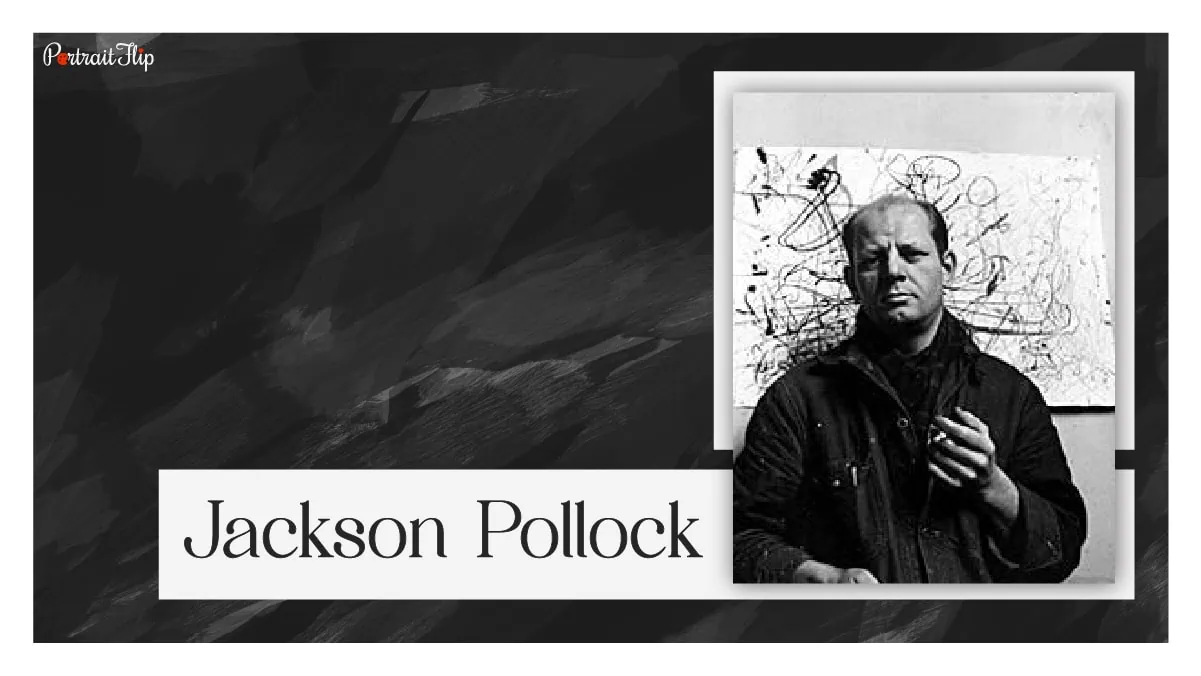
One of the inventors of action painting, Jackson Pollock, was the most influential artist from the US.
Jackson was born to a farmer in 1912. He experienced a lot of native American culture when he was on surveying trips with his father.
As Pollock himself acknowledged, his early memories and enthusiasm for native American artworks had a significant influence on his early artwork.
Later, he traveled to New York City, where he got a job working at an experimental workshop for a Mexican muralist.
Here he was introduced to liquid paint and pouring techniques on canvases, which he called the “drip” technique.
From 1938 to 1942, Pollock got heavily into alcoholism. To get himself out of this phase, he got into drawing and started expressing his frustrations through his paintings.
After the war, Jackson got back into drip painting, and that’s when famous Jackson Pollock paintings, called “Convergence” was made.
Through this painting, Jackson wanted to highlight his motto that people should be given the liberty of speech and the right to express themselves.
But just as his drip painting methods reached the peak of their popularity, Jackson abandoned them.
He started to use darker tones in his paintings, along with an unprimed canvas.
This was called “Dark Pourings” and visualized the personal frustrations of the famous abstract artist. His alcoholism also deepened during this phase.
He later died in a car accident while he was under the influence of alcohol.
Franz Kilne (1910-1962)

Franz Kilne was a famous abstract painter who was mainly known as a master of white and black paintings.
One of the icons of Abstract Expressionism, he worked in a style that combined cubism and social realism.
He used inexpensive paint and large canvases, where his brushstrokes would bolt from one side of the canvas to the other.
These techniques allowed him to gain access to the inner circles of other action painters like Jackson Pollock and Willem De Kooning.
Franz never gave any meaning to his paintings, which allowed critics to interpret them on their own.
This gave him the freedom to work without any expectations and freely express himself without adhering to the realities of his subjects.
Frank Stella (1936-present)

Best known for his geometric and minimalist artworks, Frank Stella believed in the minimal presence of a solid subject in his famous abstract artworks.
He believed that abstraction artists didn’t have to be limited to rectilinear geometry or a single curve geometry; their work should have an impact on the viewer.
He wanted his shapes to narrate a story to his viewers.
Regardless, most of his praises are for creating abstract line paintings, which bear zero resemblance to psychological or pictorial illusions in twentieth-century painting.
Currently, Frank is residing at his studio in New York and continues to work to this day.
(Suggested read: Artists of the Renaissance.)
From Russia to the USA, these artists stood up for what they believed in and didn’t let anything stop them.
They gave every last bit of their effort to ensure that their works of art caused viewers to pause and conjure up tales that would stay with them forever.
Wouldn’t it be wonderful if your priceless memories remained with you forever, just like these paintings?
Then why not have one hand painted for you by one of our professional artists?
Heya Art Readers,
Thank you for reading this article about abstract artists all the way to the end.
If you have some more facts about artists that you would like to add, then feel free to use our comment section down below.
Don’t forget to follow us on Instagram and subscribe to our YouTube channel, where we post more interesting content for all to see.
Also, check out our blog page if you want to read more about the art world.
Frequently Asked Questions
Wassily Kandinsky is the most renowned abstract painter. A Russian native, Kandinsky lead the abstract art movement as well.
Abstract art symbolizes complex human emotions and the things which an artist wants to express in the forms of lines, symbols and patterns.
Some of the women painters of abstract art are: Helen Frankenthaler, Hilma Af Klint, Olga Rozanova, etc.
Abstract art originated from Europe in the late 19th century and it later on spread its effect in the 20th century in the USA as well.






